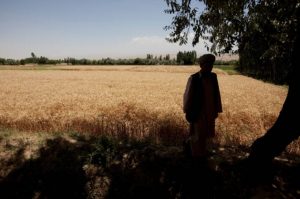Afghanistan: Efforts To Prevent a Food Crisis Before Everything Becomes More Serious
 17 September 2021
17 September 2021

FAO is working to urgently raise $ 36 million to accelerate support for Afghan farmers. The support aims to ensure that they do not lose their crops, wheat and other winter grains, which could otherwise result in a food emergency that would deepen the crisis in the Asian country. Credit: FAO
By Mario Lubetkin
ROME, Sep 17 2021 (IPS)
The traumatic events that occurred in recent weeks in Afghanistan have once again placed this Asian country at the center of the world’s attention with high-impact coverage and analysis in the media.
Perhaps one of the arguments least addressed in the current situation is the state of agriculture and food in the country and the possible effects on these sectors that, if not addressed in time, could intensify an already very delicate situation.
Failure to face the critical autumn that is approaching, the anticipated drought, the economic crisis, the instability and the COVID-19 pandemic may lead to a devastating scenario of hunger and migratory flows, both internally and abroad
In an extraordinary ministerial meeting held on Monday, 13 September, convened by the Secretary General of the United Nations, António Guterres, to discuss the urgent measures to be taken to alleviate the critical humanitarian situation in Afghanistan, the potential issue of hunger, especially suffered by girls and boys, arose in several interventions carried out by numerous countries, donors and international organizations.
Failure to face the critical autumn that is approaching, the anticipated drought, the economic crisis, the instability and the COVID-19 pandemic may lead to a devastating scenario of hunger and migratory flows, both internally and abroad.
The drought threatens the subsistence of seven million Afghans if the support for the season’s harvest does not arrive in time.
In Afghanistan, 70 percent of its population (around 36 million people) live in rural areas, and agriculture guarantees the survival of 80 percent of the population.
The Director General of the Food and Agriculture Organization of the United Nations (FAO), QU Dongyu, requested an urgent contribution of $36 million dollars to immediately address the agricultural and food situation in Afghanistan, in order to provide relief to 3.5 million people.
FAO currently supports more than 1.5 million people in 28 of the 31 Afghan provinces. Assistance in this sector must consist of technical aid, seed donation, training and small financial aid to guarantee basic nutritional needs.
The projected drought this year will reduce plantations by 20 percent and require an increase in cereal needs of 30 percent, while three million head of cattle will be at risk.
Advances in technology and information technology enable many catastrophes to be anticipated before they take place and cause human suffering increase threats to food security and rural livelihoods in countries in severe crises, like in the case of Afghanistan. Such advances require a massive intensification of these digital instruments.
The Director of Emergencies and Resilience of FAO, Rein Paulsen, considers that given the complexity, frequency and intensity of new countries that add to dramatic food crises, it is not possible to continue resorting to strategies of the past. It is necessary to advance in innovation and more efficient and wiser investments.
In this context, immediate action in Afghanistan must be based on previous experiences and adapted to have better immediate results with lower costs.
In the last five years, the number of people in the world affected by a food crisis has risen to 155 million in 2020 in 55 countries, while another 41 million face emergencies due to food insecurity, thus running the risk of suffering from famine or similar conditions unless they receive immediate assistance to survive.
More than 811 million people go hungry around the world, a trend that has been increasing in recent years.
The increase in humanitarian funding for the food sector – from $ 6.2 billion to nearly $ 8 billion between 2016 and 2019 – has been significant, although it is still not enough to provide basic emergency relief.
In the case of Afghanistan, multiple countries have listened to the request of the United Nations to undertake urgent cooperation with the country, multiplying the humanitarian emergency contributions in a country where half of the national budget depended on the international contribution.
Increasing contributions promptly and using them effectively will reduce costs.
In its new reality, the situation in Afghanistan is a challenge for the entire international community. Resolving it positively will demonstrate that it is possible to reverse negative trends in global food security. Let us be reminded there are less than 10 years to achieve the Sustainable Development Goals, the second of which is the eradication of world hunger, set forth in the 2030 Agenda.
Excerpt:
Mario Lubetkin is Assistant Director General at the Food and Agriculture Organization of the United Nations (FAO)
